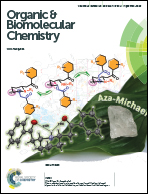New insights into the structure–spectrum relationship in S65T/H148D and E222Q/H148D green fluorescent protein mutants: a theoretical assessment
Abstract
The green fluorescent protein (GFP) variant S65T/H148D recovers the A-band fluorescence lost in the single mutant S65T, and it has been established that Asp148 is the alternate proton acceptor for the excited state proton transfer (ESPT). This mutant has been widely studied and presents unique spectroscopic properties, such as an ultrafast rise in the fluorescence (<50 fs). Also it exhibits a red-shift of the A absorption band of 20 nm with respect to wt-GFP's. The double mutant E222Q/H148D presents a very similar behaviour, at least within the experimental data available (which is scarcer than those of S65T/H148D). By means of dynamic theoretical studies we have been able to (1) reproduce and thoroughly analyse the red-shifted absorption spectra of both mutants and (2) predict the structure that the variant E222Q/H148D (for which there is no X-ray-resolved structure available) most probably adopts in water at room temperature. Our results deepen the understanding of the way GFP variants work and give some new insights into the rational design of fluorescent proteins and biological photosystems in general.



 Please wait while we load your content...
Please wait while we load your content...